The following is a translation of an interview with our Chief Game Designer Hideki Kamiya and his younger brother, originally run on Famitsu.com in December of 2017. https://www.famitsu.com/
Growing Up with Games: A Talk with the Kamiya Brothers Part 1
By Keigo Toyoda
When the dawn of video games as home entertainment began, how did two young brothers first come into contact with them? We spoke with game designer Hideki Kamiya of PlatinumGames and his younger brother, who’s not in the industry, about their youth and the role that video games played in their lives. They had a lot to tell, so we’ve split the talk into two parts.
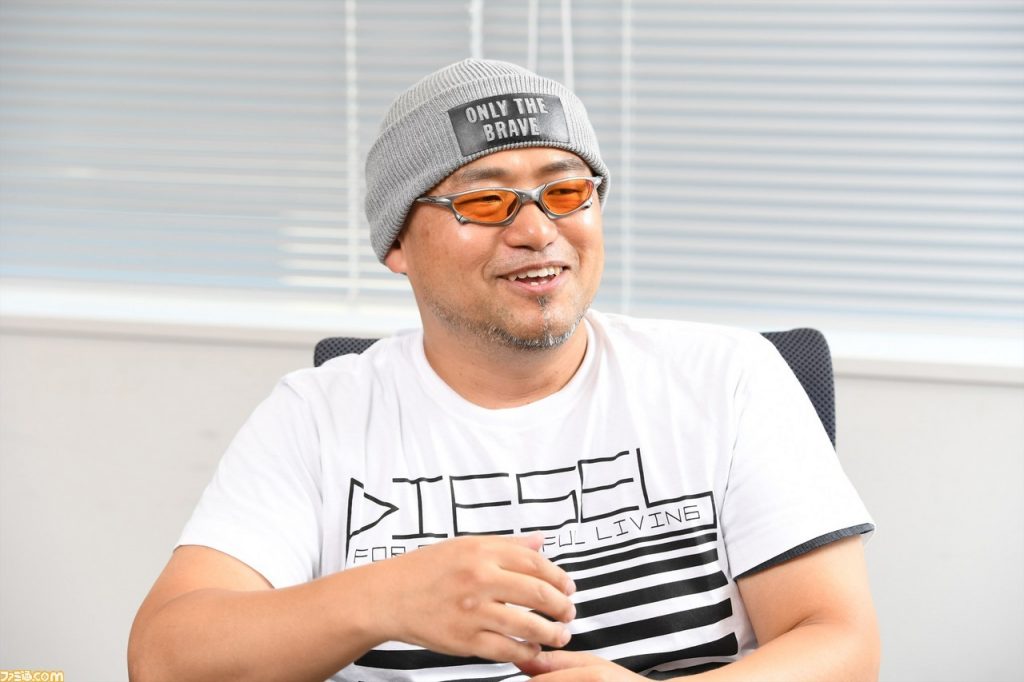
Hideki Kamiya (HK)
Game designer for PlatinumGames. Born December 19th, 1970. In 1994 he joined Capcom, working on Resident Evil 2, Devil May Cry, Viewtiful Joe, and later Okami as a member of Clover Studios. After moving to PlatinumGames, he directed the popular action game Bayonetta. He takes to Twitter daily to talk about his love for classic games, which he also touched on during his appearance on “Iwata Asks” when The Wonderful 101 was released.
Hideki Kamiya’s younger brother (YK)
Six years younger than Hideki Kamiya, he is employed in a different field. Thanks to some coaxing from his older brother, he’s agreed to join us for the talk.
Toyoda: Thank you both for joining us for this chat!
YK: I can’t believe Famitsu’s using me for an article…I’m just a regular guy. (Laughs)
HK: Famitsu said, “We want to do a talk with you and your friends Mr. Nagasawa and Mr. Takagi,” (*1) but after thinking about it for a while, I decided it would be easier to do it with you. (Laughs)
*1: Mr. Masaharu Nagasawa and Mr. Kazuyuki Takagi are two of Kamiya’s longtime friends, who’ve appeared with him in the “Fantasy Zone and Me” and “Sega 3D Reissue and Me” special columns in Famitsu commemorating the SEGA AGES 2500 series releases, as well as many others.
Toyoda: When I told Mr. Kamiya that I wanted to do an interview with him, Mr. Nagasawa, and Mr. Takagi about how fortunate and exciting it was to be kids and grow up as arcade games, PC games, and game consoles appeared and then took off, he said, “I can’t do it with them, but I could do it with my little brother.”
F
YK: That worries me.
HK: Hey, I have no idea what’s going to happen either. (Laughs)
Toyoda: Well, let’s get started. So first of all, the Kamiya brothers grew up around other lovers of video games, with friends who liked games all the way up into high school, right?
HK: Right. But after graduating high school and getting into college I left home, so my little brother and I lived apart after that. You meet all kinds of people in college—people into music, motorcycles, and all kinds of social hobbies like that, but nobody who was really into games like the guys in junior high and high school. So in college I got into a lot of other fun things, but it was a bleak time in my gaming past.
Toyoda: You went to university in Tokyo, right?
HK: I’m from Nagano, but my college was in Tokyo. Whenever I went home, I played games the whole time.
Toyoda: How did you first come into contact with video games?
HK: For kids from my generation, home consoles were still rare, so you’d play at the department store game corner when you went shopping with your parents. That was how I first experienced them, and of course my brother was there too.
Toyoda: So arcade games were your first ones.
HK: Right. My brother is 6 years younger, and he was born right before I started elementary school. I started playing at the game corner while he was still in 1st or 2nd grade, so he probably doesn’t remember… Do you?
YK: Nothing.
HK: Hold on. Before we get into it, can I draw a timeline on the white board?
Toyoda: A timeline?
HK: The major games and the release dates I remember, and the events of the Kamiya household…
-10 minutes later-
HK: That’s about right.
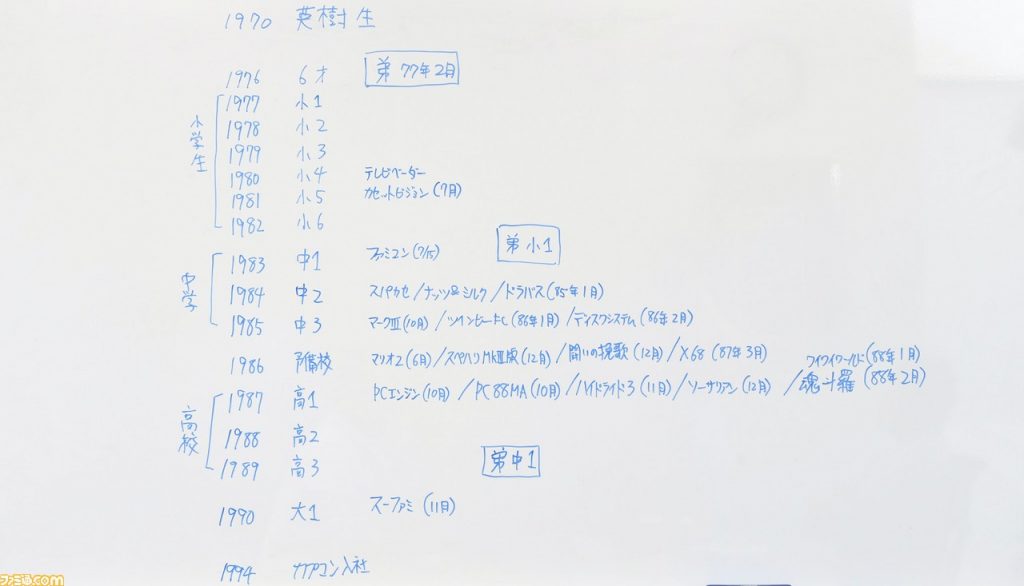 A timeline handwritten by Hideki Kamiya. It will be a point of reference throughout the interview.
A timeline handwritten by Hideki Kamiya. It will be a point of reference throughout the interview.
| Year | Event |
| 1970 | Hideki Kamiya born |
| 1976: Age 6 | |
| 1977: Elementary school, 1st grade | (younger Kamiya born February 1977) |
| 1978: Elementary school, 2nd grade | |
| 1979: Elementary school, 3rd grade | |
| 1980: Elementary school, 4th grade | |
| 1981: Elementary school, 5th grade | |
| 1982: Elementary school, 6th grade | |
| 1983: Junior high, 7th grade | NES (7/15) (YK, elementary 1st grade) |
| 1984: Junior high, 8th grade | Super Cassette Vision, Nuts & Milk, Dragon Buster (January 1985) |
| 1985: Junior high, 9th grade | Master System (October), Twinbee NES (January 1986), Disc System (February 1986) |
| 1986: Cram school | Super Mario Bros: The Lost Levels (June), Space Harrier (Master System, December), Trojan (December), X68000 (March 1987) |
| 1987: High school 10th grade | TurboGrafix-16 (October), PC88MA (October), Hydlide 3 (November), Sorcerian (December), Contra (February 88) |
| 1988: High school 11th grade | |
| 1989: High school 12th grade | (YK junior high 7th grade) |
| 1990: University 1st year | SNES (November) |
| 1994: Started at Capcom |
YK: That takes me back. (Laughs)
Toyoda: Then getting back to what we were discussing, were your parents open-minded when it came to video games?
HK: They were strict, right?
YK: They hid the AC adapter as punishment all the time.
Toyoda: I know that pain since my parents did that to me too. Was there just one TV in the house?
HK: We had one in the living room, and one in a back room for video games.
Toyoda: It wasn’t in you and your brother’s bedroom?
HK: No, it was a room where our dad laid his futon out to sleep. So… what was it the rest of the time?
YK: His bedroom?
HK: Yeah, I guess it was dad’s bedroom. Anyway, that’s where we played games.
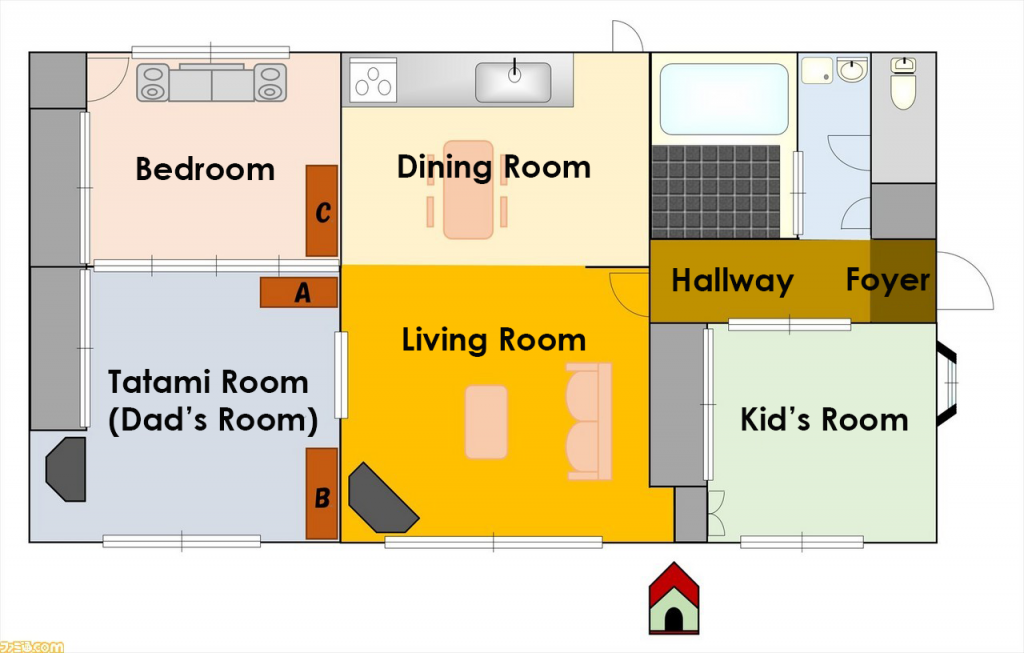 The layout of the Kamiya family home, provided by Hideki Kamiya. The room in the lower left was his father’s room, and where the TV for gaming was kept.
The layout of the Kamiya family home, provided by Hideki Kamiya. The room in the lower left was his father’s room, and where the TV for gaming was kept.
Toyoda: We’ll talk more in depth about that later, but let’s get back to arcade games. You said that the arcade games in the department store game corner were what shaped your feelings toward games.
HK: That’s right. I got really interested in video games and arcade games. I was mystified by seeing characters on the TV screen and hearing the 8-bit sounds. That was when I started to like games in general.
Toyoda: With no console at home, your first chance to play games was while out and about.
HK: Because there still were no home consoles. On Twitter I get asked, “What was the first video game you played?” and I really don’t remember. I’d be at a hotel game corner or a bowling alley game corner, just playing whatever was there.
Toyoda: There were a lot of knockoffs then too.
HK: Yeah. There were a lot of strange games that still make me think “What WAS that game?” There are some that even if I look them up, I still can’t find out who made them. There was one that looked like Time Pilot (*2) from Konami, with a black and white airplane dogfighting. No idea what it was, but it was in San Ai.
*2: Time Pilot is an arcade shooting game released in 1983 by Konami (currently Konami Holdings) in which players control an airplane that can time slip to shoot down enemy aircraft. It was known for 360 degree scrolling controls.
YK: San Ai was the big retail store in our neighborhood. The second floor had a bowling alley with lots of arcade games.
HK: And aside from arcade games, they had Namco’s clay shooting game…the orange one.
Toyoda: Shoot Away (*3).
※3: Shoot Away is a clay shooting game that was released in 1977 by Namco (currently Bandai Namco Entertainment). It focused on a feeling of authenticity, using realistic parts for the attached gun peripheral.
YK: Ah, they did have that.
HK: It was an era where you had Shoot Away in the bowling alley. Hey, do you remember that projection racing game? The one that looked like cellophane…the cabinet was shaped like a race car too.
Toyoda: Maybe you’re thinking of Formula X (*4)?
HK: You’d blow up if you hit something. That explosion had me shook as a kid…you don’t remember?
*4: Formula X is an arcade racing game that was released in 1973 by Nakamura Manufacturing (later Namco). It used a projection screen and a nearly to-scale F1 racer replica cabinet. A smaller, improved version was released in 1976 as F-1.
YK: Nah, nothing.
HK: You might not have been born yet. But after that, things like Pac-Man (*5) and Galaxian (*6) started to come out. Games like Piccadilly Circus (*7) and Mountain Climber (*8) too.
*5: Pac-Man is an arcade game that was released in 1980 by Namco (currently Bandai Namco Entertainment). Players control Pac-Man to avoid ghosts and eat all of the dots in a level to beat it. By eating a Power Pellet, Pac-Man can eat the ghosts to get rid of them temporarily.
*6: Galaxian is an arcade shooting game that was released in 1979 by Namco (currently Bandai Namco Entertainment) and was their first shooting game. The goal is to eradicate formations of alien enemies.
*7: Piccadilly Circus is a roulette-style medal game that was released by Konami (currently Konami Holdings) in which players insert a medal and then choose the number that they believe will be selected.
*8: Mountain Climber is an electromechanical prize game that was released in 1981 by Komaya. Players use “back” and “forward buttons” to avoid obstacles and make it to the summit within the time limit. Each obstacle has a unique sound effect and poses a different problem, and players are knocked back to start if they touch an obstacle.
YK: Stuff like the parrot roulette game too. (Laughs)
Toyoda: The Chatter-Parrot (*9), that’s a deep dig.
*9:The Chatter-Parrot is a roulette prize game that was released by Kato Manufacturing. Players press a button to stop the roulette at one of four places to win a prize. The machine says “Good morning, good morning,” and “Hello, hello!” while in attract mode.
HK: Yeah. (Laughs) Back then I played a lot of electromechanical games. You remember the first game you played?
YK: My first game? I’m not sure…
HK: You don’t remember the very first one, right?
YK: No, but it had to have been an arcade game.
HK: Think of where we used to go all the time…
YK: Ito Yokado.
HK: Yes! Ito Yokado’s game corner!! Right next to quality games like Sasuke vs. Commander (*10), Jump Bug (*11), and River Patrol (*12), they had stuff like New Zig Zag (*13). They had a Monaco GP (*14) cabinet too. At Inoue they had Make Trax (*15) and Sega’s Turbo (*16). And there was Hayashibe.
*10: Sasuke vs. Commander is an arcade game that was released in 1980 by Shin Nihon Kikaku (currently SNK). Players move left and right, throwing daggers to take out enemies. It has a Japanese taste that was rare at the time, as well as some fairly dramatic depictions.
*11: Jump Bug is a side-scrolling, shooting action arcade game released in 1981 by Sega (currently Sega Interactive). Players jump and shoot obstacles and enemies, collecting money and jewels as they head for the goal. It has a psychedelic color scheme.
*12: River Patrol is an arcade game that was released in 1981 by Orca. Players rescue drowning victims, turning their rescue boat left or right with the stick, and pressing a button to move it forward. Players move against the current, so the boat drifts slowly down river when the button is not pressed.
*13: New Zig Zag is an imitation of Dig Dug, with an additional pickaxe item.
*14: Monaco GP is a realistic arcade racing game that was released in 1979 by Sega (currently Sega Interactive), in which players use the shift lever and gas pedal to accelerate and slow down.
*15: Make Trax is an arcade game that was released in 1981. Players move in four directions to paint over the entirety of the on-screen maze.
*16: Turbo is an arcade racing game that was released in 1981 by Sega (currently Sega Interactive) with controls for steering, gear shifting, and a gas pedal, as well as an overhead view with depth.
YK: Oh yeah, Hayashibe.
Toyoda: Hayashibe?
YK: There was a big department store called Hayashiya.
Toyoda: Hayashibe and Hayashiya?
HK: Ah, it’s pretty confusing without an explanation. Hayashiya was a proper department store with a toy department and a game corner. Across the way from Hayashiya, there was a smaller, 3-floor store called Hayashibe. They only sold women’s clothing, but the year when my brother maybe about to start elementary school, they suddenly got a game corner. And the lineup was really good. The Hayashiya game corner was more electromechanical machines than arcade games, but Hayashibe had about 30 table cabinets just lined up! There were games I’d never seen before. You remember that, right?
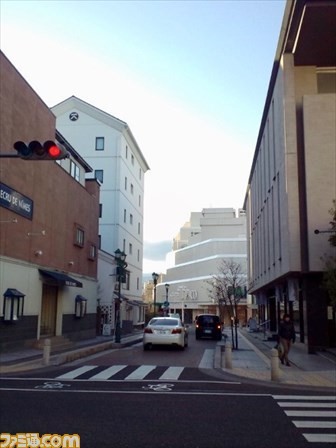 “This was the former location of Hayashiya. It was where the white building in the center is, and Hayashibe was across the street from that.” (Photo and comments courtesy of Hideki Kamiya)
“This was the former location of Hayashiya. It was where the white building in the center is, and Hayashibe was across the street from that.” (Photo and comments courtesy of Hideki Kamiya)
YK: No, not really…
HK: What? Why! Every time mom went to Hayashiya to shop, we’d go with her, tell her we were going to look at the toys, then run over to Hayashibe to play games. We went together and you’re telling me you forgot!
Toyoda: They had older tame cabinets too?
HK: Yep. Everything from minor to major titles. I remember them having stuff like Rally-X (*17), Qix (*18), and New York! New York! (*19).
*17: Rally-X is an arcade game that was released in 1980 by Namco (currently Bandai Namco Entertainment) in which players control a blue car, avoiding red cars and boulders as they proceed through a maze-like stage to pass through ten checkpoints marked with flags.
*18: Qix is an arcade game that was released in 1981 by Taito. In this game, players move a marker around the screen to connect lines and claim the designated amount of space while avoiding the QIX, an erratically moving linear shape.
*19: New York! New York! is an arcade shooting game that was released in 1980 by Sigma Enterprises. It has Statue of Liberty visuals that leave a distinct impression. There is also an Arcadia of my Youth version with different background graphics and music.
Toyoda: New York! New York! is that distinctive shooting game with speech synthesis, right?
HK: The lesser known games were REALLY unknown, whack-a-mole games, games I’d never seen from unknown makers. It was kind of a mysterious place. On top of that, it wasn’t the kind of store kids went to in the first place, so it was always kind of deserted and a spot only we knew about. The Hayashiya game corner was always overrun with kids, but Hayashibe was quiet and we could play games as much as we wanted to. Mom wanted to concentrate on shopping so she’d give us a lot of change and tell us to go play. We made sure to hold on to that change tight and choose our games carefully.
Toyoda: Ok, I understand that your formative experience with video games was with arcades. What about home gaming?
HK: There was a kid in our neighborhood named Toshiaki who got picked on a lot. You know who I mean, right?
YK: I remember him.
HK: He was 2 years older than me and his house…you been there before?
YK: Nope, never…
HK: Toshiaki’s parents bought him all kinds of toys. There’s always one kid like that in class, you know? That was Toshiaki, he had light gun games, consoles from overseas with names we didn’t know—that was when I was maybe in 3rd grade. In 1981, when I was 11, the Cassette Vision (*20) came out. Toshiaki got it and that was about the time I was hanging out at his house the most. I was there constantly during summer vacation playing Cassette Vision the whole time, but Toshiaki had a short fuse, and was quick to swing if you made him mad. Even if we were just playing The Game of Life, if I landed on a good square he’d glare at me—but I couldn’t fight back. (Laughs) Games had me hooked to the point where I’d take that risk to play.
*20: The Cassette Vision is a home video game console that was developed and released by Epoch Co. in 1981. Originally released for 12,000 yen with AC adapter sold separately at 1,500 yen, they were later sold together for 13,500 yen. It used a system where cartridges themselves contained each cartridge contained a single IC unique microprocessor, letting users play different games by changing the cartridge.
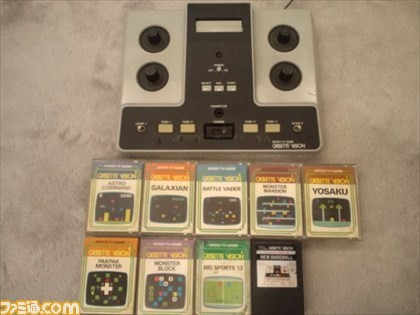 “This is my Cassette Vision. I always wanted one as a kid, so I bought one as an adult.”
“This is my Cassette Vision. I always wanted one as a kid, so I bought one as an adult.”
(Photo and comments courtesy of Hideki Kamiya)
Toyoda: What games did you play on Cassette Vision?
HK: Games like Yosaku (*21), Galaxian, Astro Command (*22), and PakPak Monster (*23). Toshiaki’s parents bought him cassette after cassette.
*21: Yosaku is a Cassette Vision launch title in which players control Yosaku the lumberjack, chopping down trees while dodging wild boars and vipers.:
*22: Astro Command is a Cassette Vision shooting game that was released by Epoch in 1983. Players maneuver their ship through city areas and enemy bases while shooting down enemy ships. In addition to losing ships from running into enemies or obstacles, it’s also game over if you run out of fuel. Destroy fuel tanks to refill.
*23: PakPak Monster is a Cassette Vision game in which PakPak Man eats tablets while avoiding monsters. He can fight back if he eats a power tablet.
Toyoda: Toshiaki was really special, huh?
HK: Now this was back before the Nintendo Entertainment System (NES) (*24) came out, but I had some friends with the Nintendo Color TV-Game 15 (*25), and home consoles started to spread. I even had a classmate with an Atari 2600 (*26). But our parents wouldn’t buy a console for us, so we had to keep going to friends’ houses to play. Anyway going back to Cassette Vision, when I was in 4th grade TV Vader (*27) came out. Just when I was puzzling over what to ask for as a birthday present our dad, who was hooked on Space Invaders (*28) at the local café, “suggested” I might like a TV Vader.
*24: The Nintendo Entertainment System, known colloquially as the NES, is an 8-bit home video game console that was first released by Nintendo in 1983. The CPU is located in the base unit, with the individual game programs and data on cartridges (ROM cassettes). It came with two rectangular controllers that were connected directly to the base, with a directional pad on the left side and an A and B button on the right. This layout would later become the standard.
*25:The Color-TV Game 15 is a home game console that was released by Nintendo in 1977. The console contains 15 games, which are chosen by moving a lever. It included games like Tennis A/B, Hockey A/B, Ping-Pong, and so on.
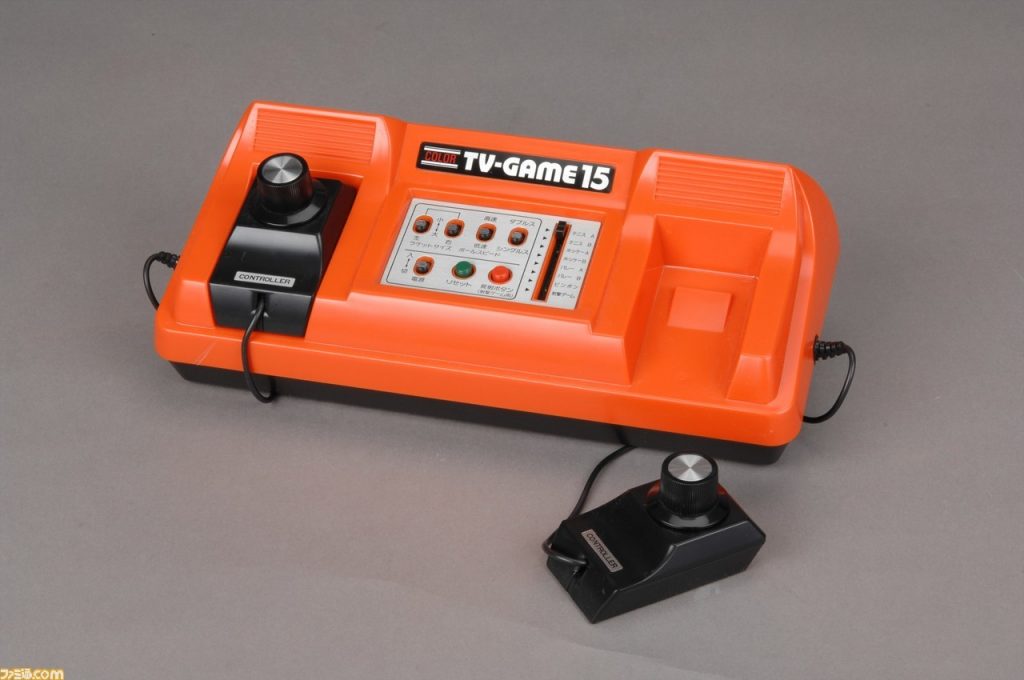
*26: The Atari 2600 is a home video game console that was released by Atari in 1977. Originally sold as the Atari Video Computer System, it was also known as the Atari VCS. It has a distinctive woodgrain design.
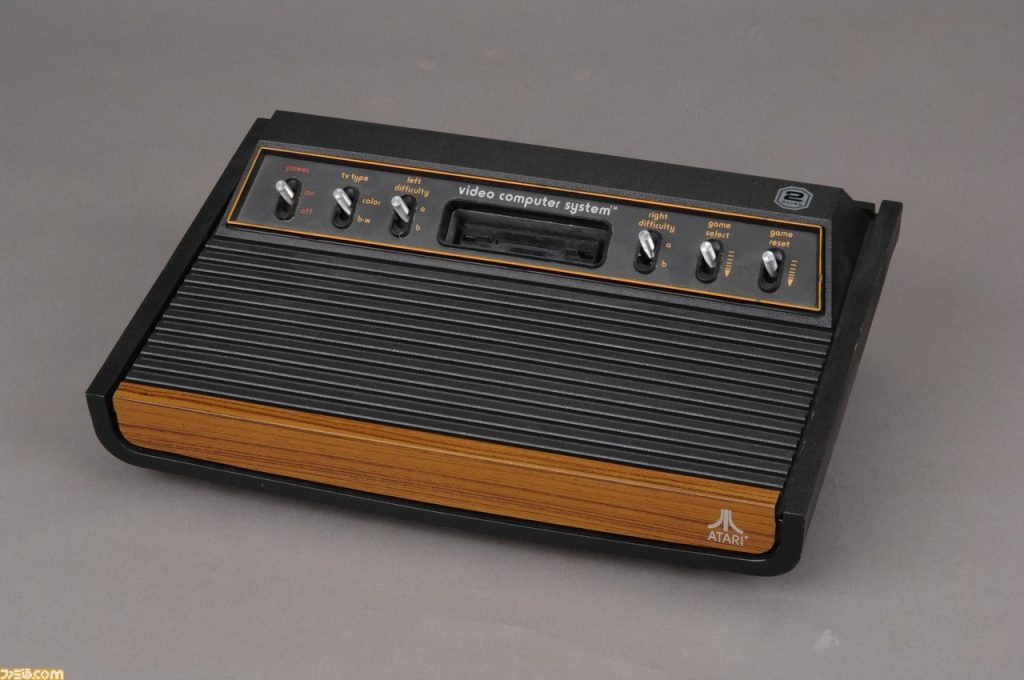
*27: The TV Vader is a home video game console that was released by Epoch Co. in 1980. It contains a version of Space Invaders adapted for home play.
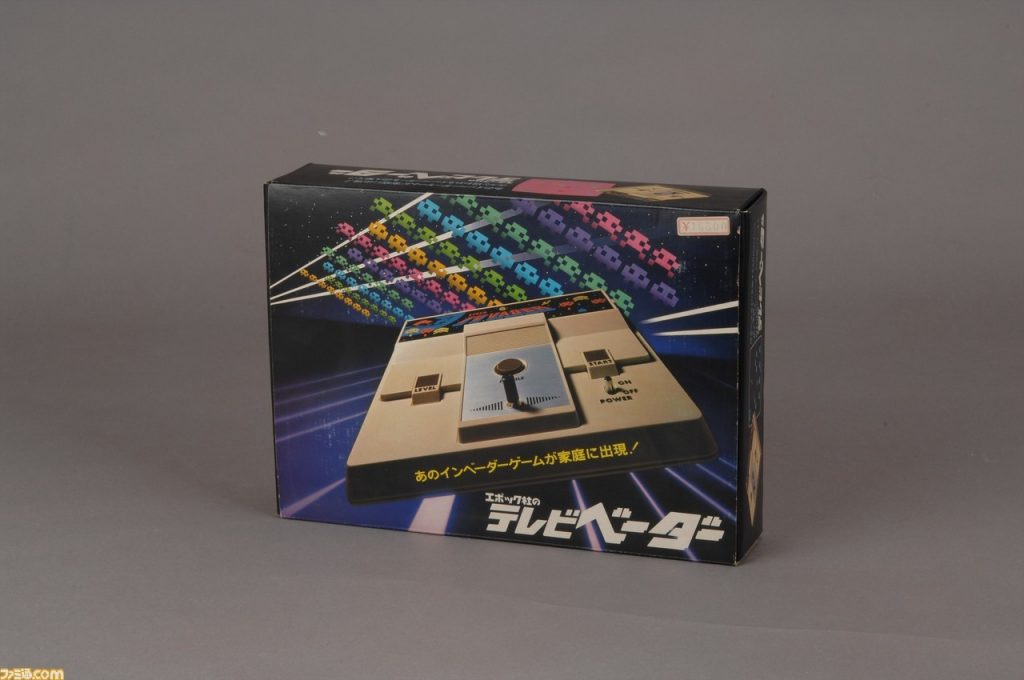
*28: Space Invaders is an arcade game that was released in 1978 by Taito. Players control mobile cannons to shoot down invaders as they descend from the top of the screen, destroying all of them to clear the stage.
Toyoda: So even though it only played Space Invaders, that’s when you got a home console, right?
HK: Actually, everyone in my class was into RC cars so I asked for one of those instead. (Laughs)
Toyoda: (Laughs)
HK: I think it was the biggest mistake I’ve ever made. I got bored of RC cars really fast and really wanted to play TV Vader.
YK: Was that before the Mountain Man?
HK: Yeah. I don’t remember the name, but the RC car I asked for was a Porsche with blinkers that lit up when it turned. I got the Mountain Man when I was in 6th grade. Ah, “Mountain Man” was another RC car, a 4-wheel drive Chevy Blazer called Mountain Man. It was the most expensive RC car advertised at the time and all the kids drooled over it. My parents got it for me as a surprise birthday present. I was so moved, I promised “I’ll study hard!”…but that promise didn’t come to bear. (Laughs) At any rate, since I missed out on getting a TV Vader in 4th grade, it would still be a while before we got a game console.
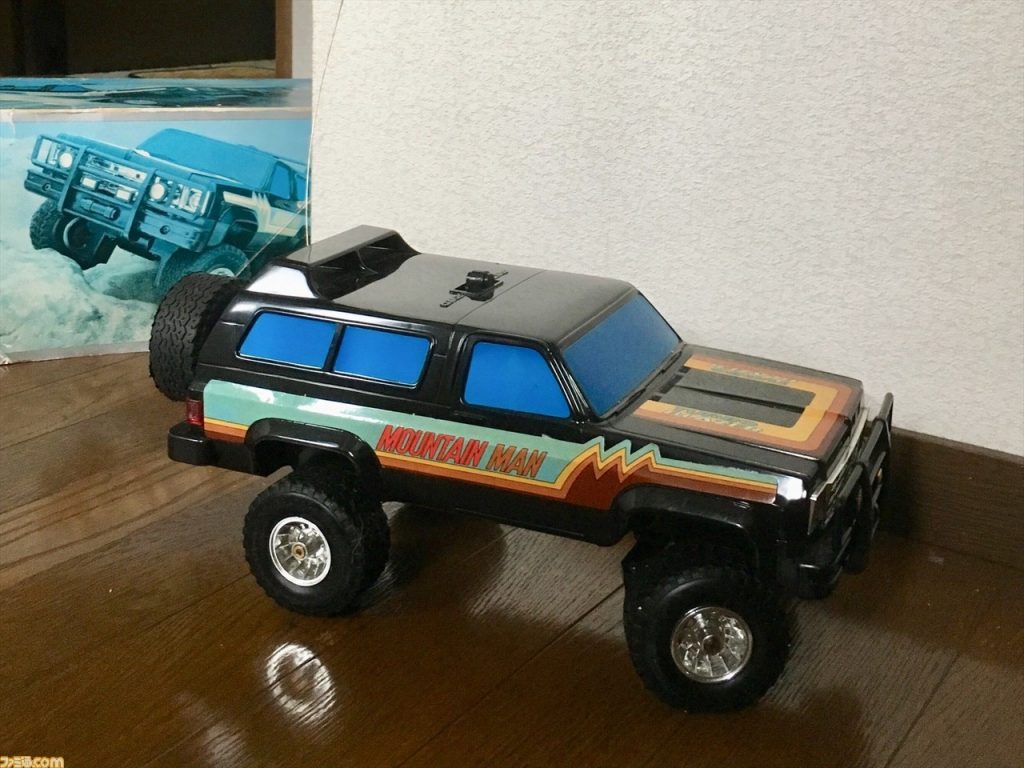 “This is the Mountain Man, bought for me when I was in 6th grade. It’s still at my parents’ house.” (Photo and comments courtesy of Hideki Kamiya)
“This is the Mountain Man, bought for me when I was in 6th grade. It’s still at my parents’ house.” (Photo and comments courtesy of Hideki Kamiya)
Toyoda: You didn’t get any Game & Watch (*29) or portable electromechanical games either?
*29: Game & Watch was a series of LCD portable game devices first released by Nintendo in 1980. The name is derived from the device’s secondary function as a clock when not in use for play. Each device contains one game written to it, and the first game released was Ball.
HK: We had some electromechanical games. The biggest one I remember getting was the Tomy Missile Strike (*30) LED game I got on my birthday when I was in 3rd grade. Remember Missile Strike?
*30: Missile Strike was an electromechanical game released by Tomy (currently Takara Tomy) in 1979. Players take aim at enemies and blast them out of the air with missiles.
YK: I remember that if you pushed the button halfway and stopped the missile when it hit the invader, you could continue to rack up points. Was the game in the red case after that?
HK: Jet Fighters (*31) came later. Dad got that at pachinko.
*31: Jet Fighters was an electromechanical game released by Gakken in 1979. Players control a missile platform to shoot down fighter jets that come in from both sides of the screen.
Toyoda: (Laughs)
YK: You reclaimed Jet Fighters lately, right?
HK: Yeah. It had sentimental value, so I bought it from an auction.
Toyoda: “Reclaim” is an interesting way to put it. (Laughs)
HK: I also used to play Race ‘N’ Chase (*32) a lot. It was a police car game in a blue case. Dad probably got that at pachinko too. (Laughs) You had to get close to the criminal’s car as he shot at you and eventually catch him. It’s kind of like the ancestor to Chase H.Q. (*33) At this point I remember the patterns of the cars and bullets well enough to beat it with my eyes closed once I turn it on. (Laughs)
*32: Race ‘N’ Chase is an electromechanical game that was released by Bambino. Players move a police car left and right while avoiding oncoming cars and pursuing gangsters. Press the “capture” when directly behind the gangsters’ car to arrest them.
*33: Chase H.Q. is an arcade game that was released by Taito in 1988. Although it is a racing game, the goal is to ram into criminals’ cars with your undercover police car, making them stop so they can be arrested.
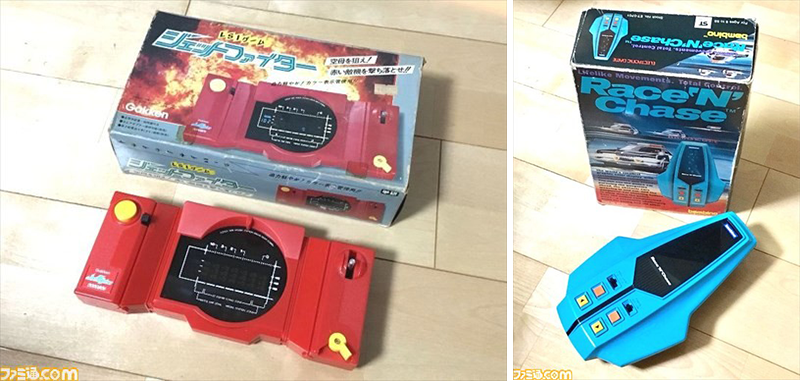 “These are Jet Fighters and Race ‘n’ Chase games that I recently reclaimed at auction.” (Photos and comments courtesy of Hideki Kamiya)
“These are Jet Fighters and Race ‘n’ Chase games that I recently reclaimed at auction.” (Photos and comments courtesy of Hideki Kamiya)
Toyoda: You played it that much, huh?
HK: Indeed. I reclaimed that lately too. (Laughs)
YK: We had a few Game & Watch games too.
HK: We played the LCD games that were popular then too. I played the Game & Watch version of Donkey Kong (*34) the most. The whole family did a score attack run on New Year’s Eve.
*34: The Game and Watch version of Donkey Kong was released by Nintendo in 1982 and is a dual screen collapsible device. Players jump over barrels to reach the crane at the top and release the hooks of Donkey Kong’s platform. It was the first game to use a directional pad.
YK: Hideki got Donkey Kong, and I got Green House (*35).
*35: Green House was the fourth dual screen Game and Watch device, and was released in 1982. Players go back and forth between the two screens spray bugs that get close to the plants, and more points are given for spraying bugs closer to the plants.
HK: Even though it had two screens like Donkey Kong I told you it wouldn’t be fun, but you asked for it on your birthday only to get bored immediately…
YK: Hey, I can get what I want for birthday. (Laughs)
HK: By the way, I recently bought both Donkey Kong and Green House at auction and gave my brother Green House as a present, but he still had the old one so now he has two. (Laughs) But back then, it wasn’t something we could just get whenever we wanted, so in my elementary school graduation essay I listed every game I wanted at the time.
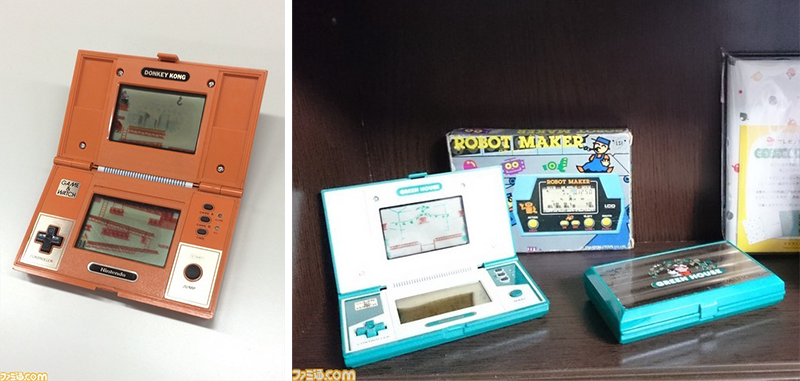 “I found Donkey Kong at a general store as an adult. I bought Green House from an auction and the Robot Maker you see behind it in the picture was something my brother had as a kid, so I got that too.” (Photos and comments courtesy of Hideki Kamiya)
“I found Donkey Kong at a general store as an adult. I bought Green House from an auction and the Robot Maker you see behind it in the picture was something my brother had as a kid, so I got that too.” (Photos and comments courtesy of Hideki Kamiya)
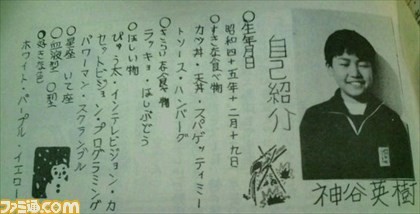 From Hideki Kamiya’s elementary school graduation essay. Under “Things I Want” it lists Pyuta (a 16-bit gaming computer from Tomy), Intellivision, Cassette Vision, and Programming Powerman (an LCD portable game from Tomy).
From Hideki Kamiya’s elementary school graduation essay. Under “Things I Want” it lists Pyuta (a 16-bit gaming computer from Tomy), Intellivision, Cassette Vision, and Programming Powerman (an LCD portable game from Tomy).
Toyoda: So when did the Kamiya household get an NES?
HK: We got ours during New Year’s, when I was in 8th grade. January 1985.
Toyoda: Did your parents buy it?
HK: It’s kind of a complicated story. There was a chance to buy an NES during the New Year’s sales at Ito Yokado, but you had to be one of the first 10 people in line. The NES was a smash hit and at the time you couldn’t find any left to buy, so we got up at 4 AM and went to Ito Yokado.
Toyoda: That’s like me when I’m going to buy Gundam models. (Laughs)
HK: But when we to Ito Yokado, there were already 10 people in line. So unfortunately, that part of the story ends with us as losers, not victors.
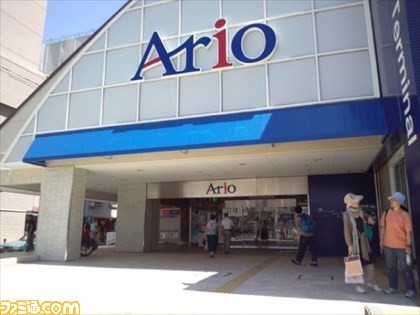 “This is the site of the old Ito Yokado. It’s a different store now, but back then 10 people were lined up to by a limited edition NES. (Photo and comments courtesy of Hideki Kamiya)
“This is the site of the old Ito Yokado. It’s a different store now, but back then 10 people were lined up to by a limited edition NES. (Photo and comments courtesy of Hideki Kamiya)
Toyoda: (Laughs)
HK: So we weren’t able to buy an NES, but then my cousin Shin came into the picture. He was 2 years older than me and lived in Chiba, but he visited us during summer vacation, etc. Unlike us rural guys from Matsumoto, he spoke proper Japanese.
YK: He was one cool guy.
HK: The coolest, always with cool slang, cool music, and cool clothes. We always got along really well, and when he heard we weren’t able to get an NES he said, “One of my friends wants to sell his. Interested?” Even though it had only been a little over a year since the NES was released, he offered to sell to use with 15 games included for only 30,000 yen.
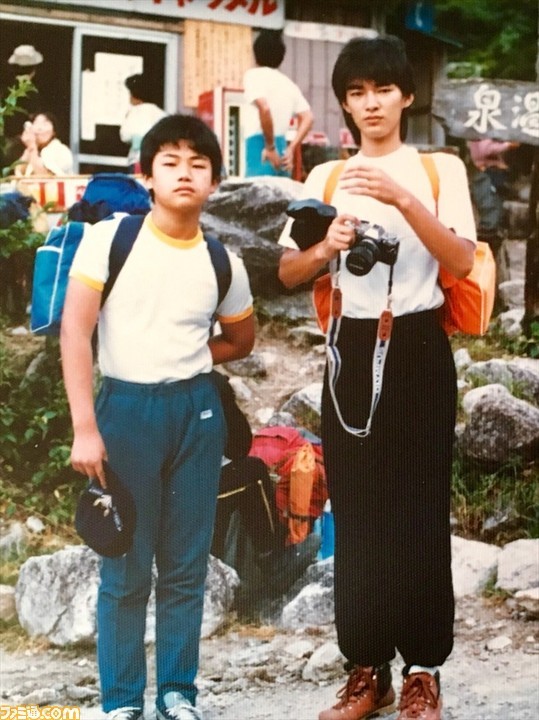 “A picture that I took with my cousin Shin back in the summer of 1985. It was the year an NES from his house in Chiba arrived at my house.” (Photo and comments courtesy of Hideki Kamiya)
“A picture that I took with my cousin Shin back in the summer of 1985. It was the year an NES from his house in Chiba arrived at my house.” (Photo and comments courtesy of Hideki Kamiya)
Toyoda: That might depend on what games were included…
HK: No way! Back then who cared what the games were!
Toyoda: (Laughs)
YK: We were even happy to play Gomoku Narabe Renju (*36).
*36: Gomoku Narabe Renju is a digital go game that was released by Nintendo in 1983 for the NES. On the package, “Gomoku Narabe” is written large in a Gothic font, while “Renju” is written in a narrow Mincho font.
Toyoda: (Laughs)
HK: We were just starved for games, now that the dream of being able to play video games at home had finally come true. Now kids have high spec games available right when they’re born but in our day we first had the arcade games, and then the awe at being able to play those games at home. I couldn’t help myself and even bought Nuts & Milk (*37) in the meantime.
*37: Nuts and Milk is an action puzzle game that was released by Hudson Soft in 1984 for the NES. Players control the hero Nuts, who is on his way to the house of his girlfriend, Yogurt. Nuts is the villain, who’s also after Yogurt.
Toyoda: Even without the actual console…
HK: It was the anticipation. Dreaming of the day I’d finally have the console, I just kept reading the box and the instruction booklet. Then I got the offer from Shin and hoped Nuts & Milk wasn’t one of those 15 games, and it wasn’t.
YK: It was definitely a miracle.
HK: So just like that, I had 16 games at once.
Toyoda: You must have been the classroom hero!
HK: Yeah, friends kept saying, “Let me borrow something, let me borrow something!” like I was an NES game library. Matsui who sat in front of me said, “I’ll lend you Galaxian, so let me borrow something.” In my head I’m thinking, “I’m don’t really want Galaxian.” so I said “Matsui, all you have is Galaxian.” (Laughs) I ended up letting him borrow Xevious.
*38: Xevious is a vertically scrolling shooting game that was released by Namco (currently Bandai Namco Entertainment) in arcades in 1984, and then ported to the NES in November of the same year. Players control the ship Solvalou, using its Zapper to take out flying enemies and the Blaster to attack ground forces. With natural environments like forests and deserts, visual gradations, and polished story depictions, it rose above its contemporaries.
Toyoda: How magnanimous. (Laughs)
Kamiya brothers: (Laugh)
Toyoda: By the way, did you pay Shin for the NES and games with your allowance?
HK: Since it was New Year’s, I paid for it with the money I got for that.
Toyoda: Did you and your brother put your money together?
HK: No, I just used mine. He was still just in 2nd grade then, so he was still content to just play with me if I got something, and not that into games yet himself.
Toyoda: So you got an NES almost out of nowhere, but around that time Sega would have already been past the SG-1000 (*39) and on to the SG-1000 II (*40). Was a Sega console not an option?
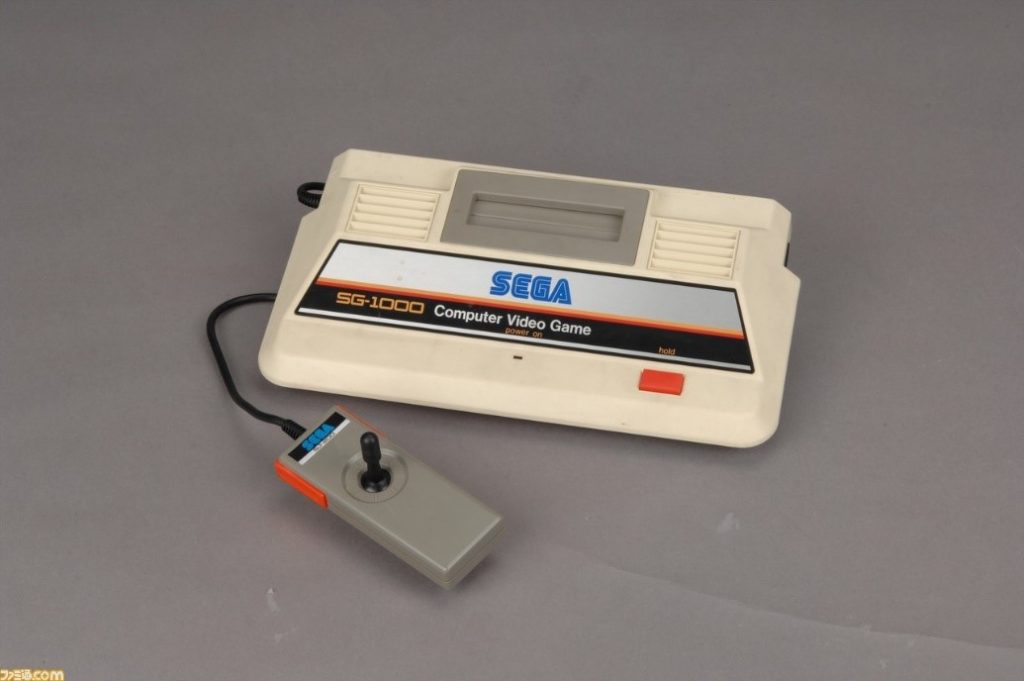
*39: The SG-1000 is a home video game console that was released by Sega Enterprises (currently Sega Games) in 1983. “SG” is an abbreviation of “SEGA GAME”, and the console is a keyboard-less, lower priced version of their SC-3000 gaming computer (“SC” being an abbreviation of “Sega Computer”) intended only for playing video games. In addition to playing Sega’s proprietary game cartridges, it could also be used with Othello Multivision cartridges from Tsukuda Original.
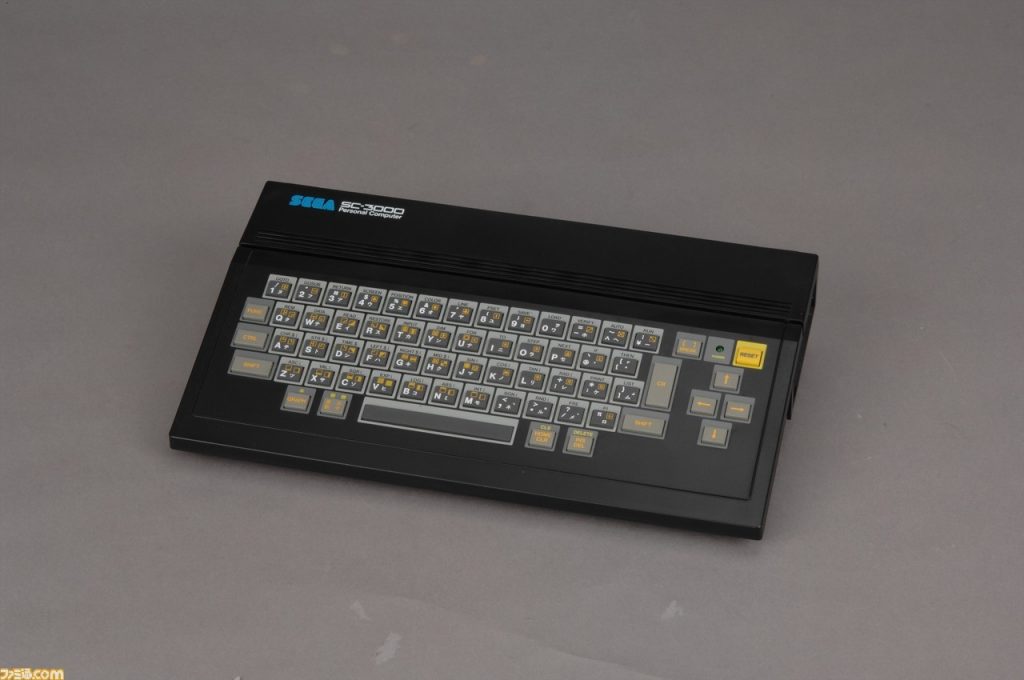
*40:A more streamlined version of the SG-1000, the SG-1000 II was released by Sega Enterprises (currently Sega Games) in 1984. It came packaged with 2 proprietary Joypads that could be stored inside the base unit if the sticks were removed.
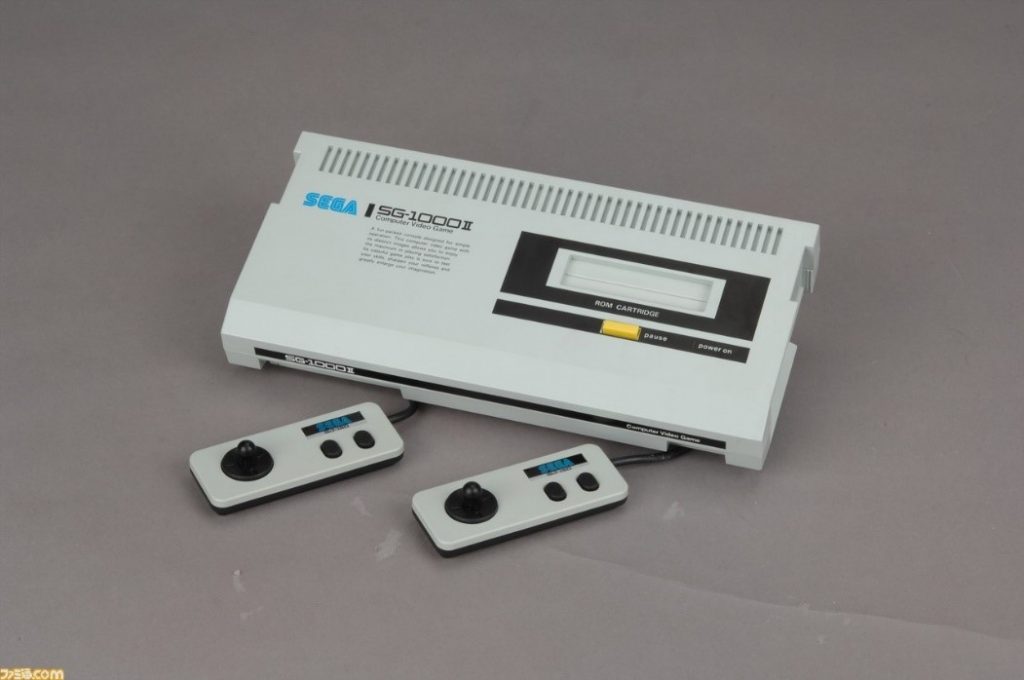
HK: I actually have a little story about that. By the time I started junior high, the NES was starting to get popular at school too. There were NES commercials on TV, and all the kids were talking about how you could play games from the arcade at home, and how they looked just like the real thing. Compared to that, Cassette Vision was almost prehistoric.
Toyoda: The sprites were still pretty rough.
HK: The NES was a revolution, with those colorful and detailed graphics. Of course all anyone talked about was the NES but like I said before, you couldn’t find them in stock anywhere. That was when this kid in my class named Kanbe told us that he broke down and bought a Sega, which was what everyone called the SG-1000 those days. We’d seen our first deserter from the Great NES Wars.
Toyoda: Deserter. (Laughs)
HK: I thought, “He couldn’t take it anymore and gave in.” These days I can appreciate the unique flair of the SG-1000, but back then I saw the monochrome characters and jerky scrolling on the toy store demo TV and thought, “Nah.”
Toyoda: (Laughs loudly) I had an NES too, but I also bought all the Sega systems from the SG-1000 II and onward including the Sega Mark III (*41) and the Sega Master System (*42), so I appreciate the good points of both lines.
*41: The Sega Mark III was a home video game console released by Sega Enterprises (currently Sega Games) in 1985. While maintaining compatibility with the SC-3000 and Tsukuda Original’s Othello Multivision, it improved on simultaneous color display, sprites, and scrolling functionality.
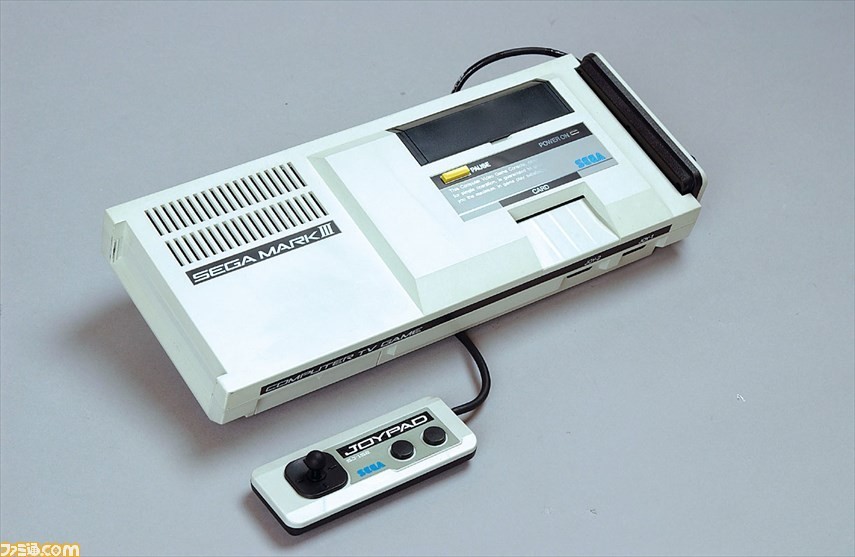
*42: Originally sold as the North American version of the Mark III by Sega of America in 1986, the Sega Master System was then reverse imported back into Japan and released in 1987 with additional FM audio and built in rapid fire functionality.
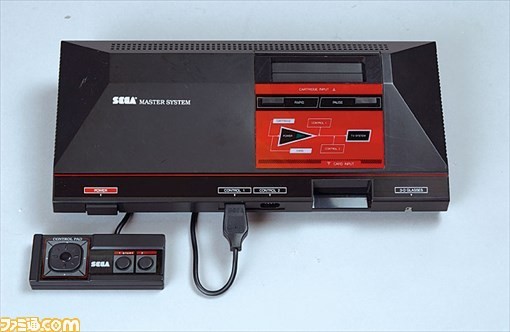
HK: I finally got there too, as an adult. (Laughs) Kids from that time who knew about the NES definitely preferred it. But no one was actually able to buy one, so no one had it. In the midst of all this Kanbe bought a Sega, so all the kids who were dying to play video games were like, “Hey, let’s go over Kanbe’s house to play Sega.” You don’t know Kanbe do you?
YK: Nope.
HK: When we got to Kanbe’s house, everyone looked jealous. He had games like Star Jacker (*43), Orguss (*44)—not that Orguss was very good.
*43: Star Jacker was a shooting game released by Sega Enterprises (currently Sega Games) in 1983 for the SG-1000. Players left a mothership and used separate anti-air and anti-ground weapons to destroy enemies and return to the mothership.
*44: Orguss was a shooting game released by Sega Enterprises (currently Sega Games) in 1984 for the SG-1000. Based on the anime Super Dimension Century Orguss, in this game players switch between Orgroid and Flyer forms. The Orgroid form has high attack and defense, while the Flyer moves more quickly with the game’s scrolling speed increasing as well.
Toyoda: That unique flair. (Laughs)
HK: Even though I initially thought Kanbe had given up, when I saw the console hooked up to his TV I was floored. And when I got home I asked my dad…all right, now I remember. Dad wasn’t big on expensive purchases, especially for something like video games, but I told him that I really wanted a game console. I said “Since the NES is sold out everywhere, I’ll take a Sega.” But my dad said “Don’t give up and settle for something you don’t really want. Be patient and buy what you want!” (Laughs) To me, he was basically saying “You can buy an NES,” so I took that as insurance and got really happy, saying “Then I’ll buy an NES!” Looking back, what my dad said then changed my gaming life. If I’d settled for the SG-1000 II, the fate of the Kamiya brothers may have changed greatly. (Laughs)
Toyoda: So that’s how you ended up getting the NES.
HK: My cousin Shin came in with the offer not too long after my dad told me not to settle. Dad was already easy on Shin, and even though it was used we’re talking about an NES and 15 games for only 30,000 yen. Back then one game went for four or five thousand yen so that was an incredible deal. On top of that video games and consoles were only available at full price, since there were no used game stores. So we jumped on that deal, and our house was flush with games overnight.
YK: But Hideki couldn’t beat the computer in Gomoku Narabe Renju, and I remember him throwing the cartridge a lot.
HK: You really remember that, huh. Anyway, I couldn’t win because I didn’t really understand the rules.
YK: He’d point at the dropped cartridge and tell me “That’s no friend of ours.” I’d just think “What the hell is he talking about?”
HK: (Laughs)
YK: He threw Tennis (*45) a lot too.
*45: Tennis was released in 1984 by Nintendo for the NES. There are one and two player modes, with two player mode being a doubles competition against the CPU.
HK: Oh yeah, the pause button was broken and it got on my nerves. (Laughs) We found out later, but the reason we got such a good deal on the NES was that the pause button was broken. It wasn’t that bad really, just a loose connection that would pause the game every once in a while. Shin’s friend probably thought it was really broken because of that and decided to sell it. So we’d be playing and at the worst possible time the game would pause, and I’d get mad and chuck the game. (Laughs) Eventually my dad sent it out for repair, and it came back fixed with new round buttons on the controllers instead of the original square ones (*46).
*46: The A and B buttons on the original NES controllers were square and made of rubber. The later round buttons are made of plastic.
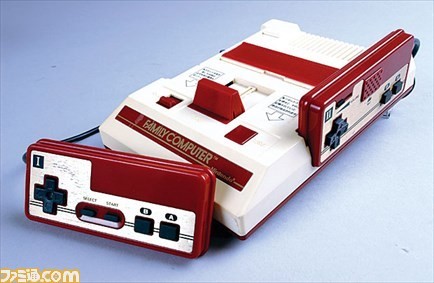
Toyoda: New Year’s 1985 must be an unforgettable memory for you.
HK: You bet. Nuts & Milk, Clu Clu Land (*47), Devil World (*48), Excitebike (*49), Xevious, Gomoku Narabe Renju, Tennis, Lode Runner (*50), Mappy (*51)…
*47: Clu Clu Land was an action game released by Nintendo in 1984 for the NES. The player character Bubbles is always moving forward, so players must stretch out her hands to grab poles and spin around them, changing her direction. Find all of the hidden gold nuggets within the time limit to beat a stage.
*48: Devil World was released by Nintendo in 1984 for the NES. Players move the character Tamagon through mazes, collecting dots and placing items in designated locations. The Devil at the top of the stage will sometimes make it scroll in the direction he points, so you have to move to avoid being squashed by the walls.
*49: Excitebike was a racing game released by Nintendo in 1984 for the NES. In addition to the regular racing modes in which players must use the gas and turbo wisely to reach the goal in time, there is also a Design Mode where players can make and race on their own courses.
*50: Lode Runner was an action puzzle game released by Hudson Soft in 1984 for the NES. Players must collect all of the gold nuggets in a stage without being caught by enemies, while using a laser gun to open holes in the floor to reach lower levels and trap enemies.
*51: Mappy was an action game released by Namco (currently Bandai Namco Entertainment) in 1984 for the NES. Players guide Mappy the police mouse through stages recovering stolen goods and using trampolines, doors, and bells to evade Goro the cat burglar and his flunkies, the Meowkies.
YK: Excitebike came in a gold box, so it stood out in the store. Another thing I remember is being told, “Say you don’t need birthday or Christmas presents, just NES games!” and going along with it.
HK: I told you to do that?
YK: Yep. It almost worked too.
HK: You were always getting Transformers. I’ll go into detail later, but I was always trying to coax my brother. (Laughs) Now not too long after getting our NES, I started going to arcades. Before that, I played arcade games at the department store game corner when I went with my parents, but that changed when I was in 8th grade and we got a transfer student in our class. His name was Machida, and we called him Macchi. We was kind of a city boy and had everyone’s attention. Anyway, one day Kanbe told us that the batting center in his neighborhood got a Dragon Buster (*52) cabinet.
*52: Dragon Buster was a fantasy action arcade game released by Namco (currently Bandai Namco Entertainment) in 1985. Players control the hero Clovis, exploring dungeons and slaying the huge dragons that wait in the depths. The variety of actions including a double jump, jumping slash, and stab attack made it stand out.
YK: The batting center out by Route 19 in Nagisa?
HK: Right. They had a few arcade cabinets there too, so were started talking about going that Saturday. We also figured we’d invite Macchi since he’d just transferred. We said, “Want to come with us to the batting center on Saturday to play Dragon Buster?” but he said, “Let’s just go to the arcade.” Everyone was up in arms. (Laughs)
YK: The arcades then were outside of the school districts and were seen as a little seedy.
HK: Everyone was like, “Huh? What? A-Arcade?” (Laughs) So that Saturday we went to the arcade near Macchi’s house, a place called Pal. It was the first arcade I’d ever been to so I followed Macchi in, a bit hesitantly… and there were table cabinets as far as the eye could see.
YK: That was the place before the hill leading up to San Ai, right? The eye couldn’t see that far in there. (Laughs)
HK: Well, it was about as big as a classroom, but it had new games you wouldn’t see at the department store and games from lesser known developers. It was truly an arcade paradise and everything was 50 yen to play!
YK: It was 100 yen at the department store.
HK: From then on every Saturday was Arcade Day, and I scrounged up my change and went every week. We were banned from going there by school, so I constantly had to sneak out of the back when PTA patrols came by. I was playing arcade games when outside and NES at home, living my best gaming life.
Toyoda: The NES came with two controllers, so did that lead to you two playing games together?
HK: We never really played games together, did we?
YK: Not really.
Toyoda: Would you mind not invalidating the point of this interview? (Laughs)
HK: It wasn’t just games; I was a tyrant lording my power over my brother.
YK: Back then I thought he was wrong in the head.
Toyoda: (Laughs)
HK: I’d be lying on the couch with the TV remote on a nearby table, and I’d say, “Hey. Get me the remote!” to my brother who’d be in another room. (Laughs)
Toyoda: (Laughs loudly)
YK: I was the remote for the remote.
HK: I was like Jabba the Hutt, refusing to get up. When I went off to college and lived by myself for the first time, the first thing I thought was, “You mean I have to get the remote myself?”
Toyoda: With that kind of past, it’s amazing you’re so friendly with each other now.
HK: Whenever we meet up I always pay for dinner, as an apology.
Toyoda: You really didn’t play games together?
HK: Not at all. For example in Twinbee (*53), he’d shoot bells too many times or take too many bells. In Contra (*54) it’s harder to see with the second player, or they scroll the screen too far and you get killed, and you end up fighting, right? If you really want to beat a game, it’s best to play solo. I remember that we used the NES so roughly that the adapter socket got really loose, to the point where shaking the console a little would cut the power. I got creative with positioning the NES so the adapter cord would stay tight, but one day he came running in and the shook the adapter out of the socket cutting the power, so I yelled at him. (Laughs)
*53: Twinbee is a vertically scrolling shooting game released by Konami (currently Konami Digital Entertainment) in 1985 in arcades, and then in 1986 for the NES and MSX computers. It features 2P co-op play with player 1 controlling Twinbee and player 2 controlling Winbee. Bells are hidden in clouds in the stages, appearing when shot. By shooting bells a certain number of times, you can change their color and the corresponding bonus points and power-up awarded when the bell is collected.
*54: Contra is a shooting action game released by Konami (currently Konami Digital Entertainment) in 1987 in arcades, and then in 1988 for the NES. Players battle a mysterious army as members of the Contra special forces, and two players can fight together.
Toyoda: There was no auto save in the NES days, so I understand.
HK: It happened once when I was playing The Tower of Druaga (*55) and I blew up and smacked him. Of course, now I feel terrible about it.
*55: The Tower of Druaga is an action RPG released by Namco (currently Bandai Namco Entertainment) in 1984 in arcades, and then in 1985 for the NES. In this game, players guide the hero Gil through the 60-floor tower of the demon Druaga. In arcades, players would leave notes about how to make certain treasure chests appear, and at other times surround the cabinet while someone was playing to prevent information from spreading.
YK: Eventually the adapter socket came out completely, and that was retirement for the NES we got from Shin.
HK: I forgot when exactly, but I went on a school trip around the time it broke completely and when I got back, my brother was playing a brand new NES.
YK: For some reason our dad was feeling particularly generous and bought a new one.
HK: From then on our second NES put in a lot of work. But Dad bought the new console by itself, even though they started selling pack-in sets. I remember thinking, “If he’d let me take care of it, we could’ve gotten another game too—even if it wasn’t very good!” (Laughs) What were you playing on NES back then?
YK: Hmm…
Toyoda: Maybe you waited for your older brother to be gone and thought, “Now’s my chance!”
YK: There was some of that too, but because I was young I didn’t know much about games. I was worried I might erase his data if I played, so I’d play a little then stop, play a little then stop, nervous the whole time.
HK: My copy of Dragon Quest II(*56) had a backup function. I’d make my little brother write down the password, then put it in when I wanted to play again. (Laughs)
*56: Dragon Quest II: Luminaries of the Legendary Line is an RPG released by Enix (currently Square Enix) in 1987 for the NES. A password system was used to suspend and resume gameplay, and this password could be up to 52 characters long, resulting in torment for players who failed to take passwords down correctly. However, most people who played Dragon Quest II it at the time have fond memories of it.
Toyoda: (Laughs)
YK: And if I’d get it wrong, he’d yell “That’s not it!”
HK: My brother had friend called Tacchan that lived in the house behind ours. He got Dragon Quest II on release day and he let us borrow his copy for a little while. Even though it was only an hour or two, it just pulled me in as I played, and we got our own copy not long after.
YK: But the name…
HK: Yeah, I just planned on playing for a little while, so I entered “Kill” as the name and started playing because seeing “Hey! Hero Kill!” just made me laugh. But then I got really into the game, eventually getting to level 5. I didn’t want that to go to waste so even after getting our own copy I kept using that password and beat the game as “Hero Kill”, which I really regret.
YK: It’s because you play around too much. I just remembered a nightmare of my own from back then, but is it ok if I share it now?
Toyoda: Go ahead. (Laughs)
YK: When I started playing Dragon Quest II, Hideki said, “I’ll write down the password for you.” At first I was pleasantly surprised, but then he made me wash the dishes.
HK: Did that really happen? (Laughs)
YK: Thinking about it now, I got a bum deal. Not only that, each time the handwriting would get harder to read each time. At first I was able to figure it out and put in the password, but it got worse and started to look like hieroglyphs.
HK: I don’t remember that at all. (Laughs)
YK: He thought it was a riot but I wasn’t laughing. Eventually it got to a point where I couldn’t read anything at all, so I asked for help and he couldn’t read it either. That was the end of my quest.
HK: (Laughs loudly)
Toyoda: It’s amazing you didn’t hate video games after that.
YK: Thinking about it now, you’re right. I did hate my brother though. (Laughs)
HK: Our parents always took his side and got mad at me if he started crying when we fought. I held a grudge and ripped up his Bikkuriman sticker collection and threw it away, but then when I wasn’t home he ripped up my kanji drill and threw it away. You remember that?
YK: I remember. I remember getting whacked hard too. (Laughs)
Toyoda: So when did games start to bring you together as brothers?
HK: I don’t think there was much of that, was there?
Toyoda: Remember why we’re here guys. (Laughs) For example, maybe when Mr. Nagasawa or Mr. Takagi came over?
HK: Maybe there was something then…
YK: No, back then I got kicked out of the room. They told me to stay out, so I have no idea what they were up to…
Toyoda: I suppose not. (Laughs)
HK: Speaking of Takagi, he called me one time when I was sleeping after being up all night. My brother woke me up saying “Takagi’s on the phone” but I was still half-asleep apparently told him to come over. But I went right back to sleep, so when he gets there I’m sleeping. With nothing else to do, he and my brother played Puyo Puyo (*57) on the Sega Genesis until I woke up.
*57: Puyo Puyo is a puzzle game that was released by Compile in 1991 for the MSX2 and Nintendo Famicom Disk System, and then in 1992 by Sega Enterprises (currently Sega Games) for the Sega Genesis. Rights for the series are held by Sega Holdings with development, production, and sales handled by Sega Games and Sega Interactive.
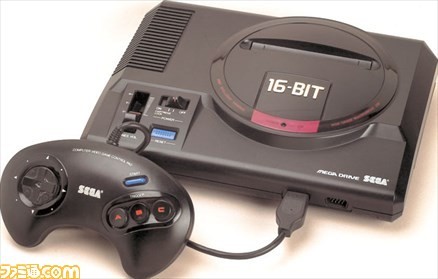
*58: The Sega Genesis is a 16-bit home video game console released by Sega Enterprises (currently Sega Games) in 1988. It was released in the United States of America and Canada in 1989.
YK: I don’t remember that…
HK: You don’t remember? Takagi always says you took it easy on him in Puyo Puyo.
YK: No, I don’t remember. Anyway, this isn’t exactly about playing video games, but when Hideki was in high school I’d sometimes sleep in his room on weekends.
HK: I remember that. There was a late night radio show on Saturdays called “Radio Is American.” Namco was the sponsor so there would be video game commercials and game music, and I listened every week.
YK: We’d stay up late and have a good time.
HK: Sometimes we’d have too much of a good time and our mom would fly into the room angry, saying “I can’t sleep with all the noise!” (Laughs)
YK: As it got closer to the start of the show Hideki would get sleepy and say, “Wake me up when it’s on,” but he’d be completely knocked out so I couldn’t wake him up and then…
HK: I’d get mad saying, “Why didn’t you wake me up!”
Toyoda: Completely rational. (Laughs)
HK: This is another thing that’s not exactly us coming together through games, but I used to coax my brother when there was a game I wanted. I’d brainwash him, saying “This is fun, so get it for your birthday.” I’m not sure if he actually wanted these or not, but I remember Twinbee and Trojan (*59) on NES. You got those, right?
*59: Trojan is a side-scrolling action game released by Capcom in December of 1986 for the NES. The main character has a sword and shield and players must balance offense and defense. The NES version adds a two-player VS. mode for competitive play.
YK: I think Contra was another one.
HK: Right, I remember going to buy it for your birthday from Ace One in front of the station, but that was also the day Dragon Quest III (*60) came out and there was a huge line. I took my time buying Contra with the long line behind me.
*60: Dragon Quest III: The Seeds of Salvation is an RPG released by Enix (currently Square Enix) in 1988 for the NES. It had the series’ first character creation system and players could make a party of up to 4 people. The popularity of the series led to long lines throughout Japan on its release date, and the phenomenon was reported on by the news media.
YK: There was Battle City (*61) too.
*61: Battle City is a shooting game released by Namco (currently Bandai Namco Entertainment) in 1985 for the NES and is a remake of the 1980 arcade game Tank Battalion. Player must use their tank to destroy a designated number of enemy tanks to beat stages.
HK: Ah, the game I lent to someone who ran off with it…
Toyoda: Twinbee, Trojan, and Battle City are all two player games.
HK: But we didn’t play them together.
Toyoda: The whole point of this talk was what again?
YK: He probably convinced me to get them because they’re two-player. He’s pretty good at that…
HK: I remember telling him to ask for Twinbee as a Christmas present even though it came out in January. I even told my parents that he said he wanted it.
YK: You’re sure it wasn’t my birthday?
HK: No, it was Christmas. That’s why I told you Santa would be late.
Toyoda: Santa was working into the New Year’s…
HK: I bought Twinbee and my mom hid it, saying she’d put it under my brother’s pillow when she got a chance. I got antsy and opened the box, playing it before he got it. (Laughs)
YK: So that’s what happened.
HK: I’d play until you got back from school, then hide it when I heard the doorknob. It was a present from Santa…
YK: With dirty handprints.
Toyoda: (Laughs) Did you buy the Famicom Disk System when it was released?
*62: The Family Computer Disk System is a peripheral for the Family Computer that was released by Nintendo in 1986 at the price of 15,000 yen. It used a proprietary disk format with a much larger capacity than a ROM cassette, and also allowed for saving and overwriting of data as well as cheaper costs.
HK: Yes. Luckily, we got it and Super Mario Bros.: The Lost Levels (*63) together. Looking at the Kamiya Family timeline, The Disk System came out when I was in 9th grade, taking high school entrance exams. I wouldn’t have normally expected to get one then, and as you can see I failed the entrance exams.
*63: Super Mario Bros: The Lost Levels was released by Nintendo in 1986 for the Disk System. It is one of the most difficult entries in the Super Mario Bros. series, with “FOR SUPER PLAYERS” written on the package.
Toyoda: Looking at the timeline, it looks like you failed because of video games.
HK: Well, that’s kind of true. (Laughs) 1986 was a dark time in the Kamiya home…
Toyoda: Were you banned from playing games while you were in cram school?
HK: Of course. The night I found out I didn’t pass, the house felt completely dark even though the lights were on. Our mom was crying in the back room.
YK: I was too young to understand.
HK: It would have been worse for me if you did. (Laughs) I think you were in 3rd grade. I still remember it well. The morning they put up the results, my dad drove to see because it was snowing. So I waited until he was gone to play Nuts & Milk. (Laughs) After a while Dad came back so I put the Famicom away and laid down on the couch, acting like I was reading the neighborhood news. Then our dad looked at me with a grim expression and said, “You failed.” Honestly, I was already sure I had so I just said “Ok.” and played it cool, but he stayed in a bad mood after that and it was rough just being in the house. Not to mention he made dinner that night because our mom was crying, and he made chicken and egg on rice.
YK: Parent and child suffering together. (Laughs)
HK: I was just as hungry as ever so I tore through it and asked for seconds. Our dad shot me a look but I was like, “I still need food!”
Toyoda: That sounds like a rough experience…
HK: While 1986 was a dark time for the Kamiya family, it was all roses for my gaming life.
Toyoda: (Laughs)
HK: Up though junior high school, you had to go to a school within walking distance of your house, but in high school, everyone went to schools a little farther away by bike and train. It worked that way for cram school too, and mine was in a place a bit past the station. That meant I went by the station on the way back home, and could go to arcade as much as I wanted to. This is when I was playing video games the most, and the lineup in 1986 was fantastic.
Toyoda: (Laughs loudly)
HK: It was a golden age. In 1985 you had games like Gradius (*64), Space Harrier (*65), and Dragon Buster, and in 1986 we got games like Fantasy Zone (*66), Salamander (*67), Arkanoid (*68), and Bubble Bobble (*69). Epoch-making games just kept coming. Gradius and Space Harrier especially had a life-changing effect on me, and when I think of the impact Gradius had on me when I first saw it…I’m pretty sure it was the Ito Yokado game corner. When I saw the laser shoot out of four options lined up, I knew an amazing game had made the scene.
And the first thing I’d seen in Space Harrier was a carrot, but when I saw if flying by at crazy speed it hit me hard enough to make me think “There’s no way I can beat this game.”
*64: Gradius is a side-scrolling shooting game that was released in arcades by Konami (currently Konami Amusement) in 1985. Players control the trans-dimensional fighter “Vic Viper” and battle subspace enemies to save the planet Gradius. The power-up system that allowed players to choose their upgrades according to preference and strategy was revolutionary.
*65: Space Harrier is an arcade shooting game that was released by Sega (currently Sega Interactive) in 1985. The second motion simulation arcade game created by Yu Suzuki (after Hang-On), it featured a cabinet that rolled as the player moved the joystick in addition to a stationary sit-down cabinet. The game contained the most advance technology of the time, with simulated 3D and depth, bright graphics using up to 32,000 colors, layered, high-speed scrolling, and audio with drums and bass.
*66: Fantasy Zone is an arcade side-scrolling shooting game that was released by Sega (currently Sega Interactive) in 1986. It boasted a number of unconventional elements like soft, pastel graphics, pop music, multidirectional scrolling (scrolling in the desired direction), and a purchase-based power-up system.
*67: Salamander is an arcade shooting game that was released by Konami (currently Konami Amusement) in 1986. The game serves as a sequel to Gradius, with player one controlling Vic Viper, and player two controlling a new craft, Lord British. There are a total of six stages, with the odd-numbered stages being side-scrolling and the even-numbered stages being vertically scrolling.
*68: Arkanoid is an arcade puzzle game that was released in 1986. It added new elements to the basic Breakout formula, such as enemies that reflect balls unpredictably and power-up items.
*69: Bubble Bobble is a fixed-screen action puzzle arcade game that was released by Taito in 1986. Players control “Bubble Dragons,” defeating all enemies on screen to beat stages. Two-player co-op play is possible, and it is in fact necessary to beat all 100 stages in two-player co-op to see the ending.
YK: OutRun (*70) was in 1986 too.
*70: OutRun is Yu Suzuki’s 4th motion simulation arcade game, following HangOn, Space Harrier, and Enduro Racer, and is known for its beautiful music and colorful stages. Players can choose which routes to take, from a total of 16. There are deluxe and standard moving cabinets, both of which move left or right in concert with player steering and vibrate when the on screen car crashes or goes off course. The stationary cabinets come in a sit-down and upright version, but the upright version was for export only and almost never seen in Japan.
HK: It was a time when experience games were really popular. Games bursting with originality came out one after the other, and all kinds of game designs were tried and tossed out in the 80s. I got to experience that first hand, when everything was fresh. I couldn’t play games at home, so I unwound on my way back from school. I failed my first exam at the cram school too. On the day before the results were posted I spent the day in the arcade and beat Arkanoid. The next day a teacher at the school told me I failed, but my friend cheered my up by saying “At least you beat Arkanoid.”
YK: That’s terrible. (Laughs)
HK: Around that time, I started to notice the difference in quality between arcade games and home console games. Arcade games had richer graphics and sound. That’s the kind of thing that got me deeper into arcade games.
YK: There was the Gradius soundtrack incident too.
HK: That’s right! Like I said, I wasn’t just interested in playing games, but in the sounds as well. It was almost like a kind of withdrawal, where I couldn’t get the rich arcade audio out of my head. I imagined how great it would be to be able to listen the music in a quiet room and away from the noise of the arcade, where I put my ear right up on the speaker to drink it in. Around that time I spotted a poster for an upcoming Gradius soundtrack release in the Ito Yokado music section. Game music soundtracks were virtually nonexistent then, so I reserved one right then and there. I was looking forward to it so much I could barely sleep. Finally the day came, and I tore out of cram school and down to Ito Yokado on my bike. I picked up the soundtrack, took it home, put the cassette in the deck and pushed the button with a shaky finger…
YK: It was the red Toshiba double deck.
HK: The music that came out of the speakers was the NES version. I was sure it would be the arcade version, so I just sat there with my jaw dropped and my mind blank.
Toyoda: I can imagine.
YK: Later our dad bought a CD player, which was still pretty rare back then, and on a whim he also picked up a game soundtrack CD.
HK: It was called The Best of Videogame Music and had audio from Namco arcade games. It had music from Xevious, The Tower of Druaga, Libble Rabble (*71)—pretty much music from all of Namco’s golden age, and I was ecstatic. Being on CD was rare too, but being able to listen to arcade game music at home was a fresh experience. I listened to it until it wore out. By the way, about a month after buying the NES version Gradius soundtrack, a game music soundtrack called Konami Game Music Vol.1 came out, and that had the proper arcade versions. In addition to Gradius, it had Twinbee, Yie Ar Kung Fu (72), and lots of others. My withdrawal was finally over. (Laughs).
*71: Libble Rabble is an arcade action game that was released by Namco (currently Bandai Namco Entertainment) in 1983. Players control the arrow-shaped Libble and Rabble to wrap up characters with the line that stretches between them.
*72: Yie Ar Kung Fu is an arcade fighting game that was released in arcades by Konami (currently Konami Amusement) in 1985, and later ported to MSX and NES. It features a variety of fighting styles and weapons. The arcade version has 11 opponents, while the MSX and NES versions have only 5. Additionally, the arcade version has a two-player mode, but it consists solely of taking turns fighting the CPU, and there is no co-op or competitive play.
Toyoda: You were really all about the arcade.
HK: That’s where it was at back then. I think my brother was probably prohibited from playing games too because of me. Or was it ok for you to play?
YK: Hmm…I don’t really remember.
Toyoda: It seems like you probably were.
HK: I’m not sure about him. What I do remember is buying the Disk System when I was in cram school. When I was working out the timeline, I was surprised when I realized that I bought the Disk System when I should have had the least freedom to play.
The Disk System was released in February of 1986, when I was 9th grade, and Super Mario Bros: The Lost Levels was released later in June, when I was in cram school. I bought the Disk System and The Lost Levels right after the game came out, so I was definitely in cram school. I probably bought it because of an article on the Disk System in a magazine our dad bought. He saw it and said, “You’re not going to buy this Disk System thing?” and I took that as a sign that it was ok to buy one.
Toyoda: (Laughs)
HK: I said, “Yeah, I’m going to get it!” Our dad laughed and said, “Nah, you can’t get one,” but I didn’t back down and said, “You just asked me if I was going to buy one!” I got 20,000 yen of my savings from our mom right then. The next day I went to Shimako, our gaming mecca, where I later bought a PC-8801 (*73).
*73: The PC-8801 is a personal computer that was sold by NEC, with the first model being released in 1981. It is colloquially known as the PC88.
YK: Shimako was a computer shop across from Kamada Junior High.
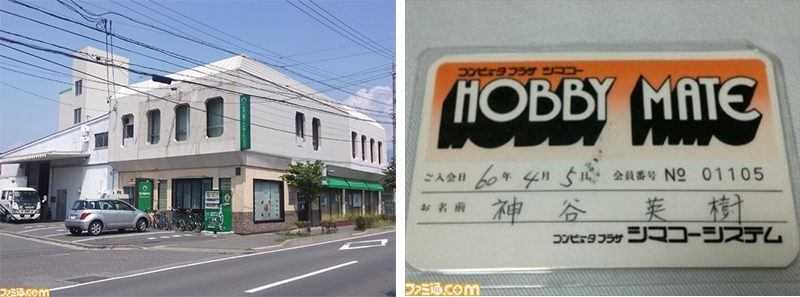 “This is the former location of Shimako. The local soccer team had been using it as an office, but the building was torn down a while ago. The picture on the right is my old Shimako member’s card.” (Photo and comments courtesy of Hideki Kamiya)
“This is the former location of Shimako. The local soccer team had been using it as an office, but the building was torn down a while ago. The picture on the right is my old Shimako member’s card.” (Photo and comments courtesy of Hideki Kamiya)
HK: On the way home from school I bought the Disk System, The Legend of Zelda (*74), and The Lost Levels. I remember that night well, because after setting up the Disk System under the NES, putting in a game, and starting it up, my parents told me to get to studying and sent me to my room. The sounds of my little brother playing The Lost Levels drifted in and I couldn’t concentrate on schoolwork (laughs).
*74: The Legend of Zelda was the first Disk System title and was released by Nintendo in 1986. Players explore fields and dungeons to find the 8 pieces of the Triforce and defeat Ganon.
YK: I remember that you used to take the disks out after they finished loading. (Laughs)
Toyoda: You took them out? (Laughs)
HK: I was amused that the games would still run with the disks taken out. I’d say, “The disks are coming with me,” and take them with me to the study room. When my brother came in saying he wanted to play a different game, I’d say, “Which one? This one?” and give him the disk like I was being generous. (Laughs) But even though I did buy the Disk System then, I still wasn’t allowed to play games. Something else major that happened in 1986 was that Space Harrier came out in December on the Master System, which had been released the previous year. Commercials for it were on TV constantly, making me really want a Master System so I could play Space Harrier at home. It was around the same time that my uncle, Shin’s dad, stopped by. He saw me holed up in the study room forbidden to play games, and slid me 20,000 yen to help me feel better.
Toyoda: That’s one cool uncle.
HK: Right? He told me to use it however I wanted to. For a student like me, I usually only got to make big purchases on my birthday, Christmas, or New Year’s, but here I was with 20,000 yen out of the blue. I was at Shimako the next day buying the Master System and Space Harrier. Come to think of it, I actually bought a lot of game systems in my cram school days. (Laughs)
Toyoda: There wasn’t much point to banning you from playing games, was there. (Laughs)
HK: When I came home happy with the Master System and Space Harrier, my dad saw them and blew up. (Laughs). I said, “Uncle said I could use the money however I wanted to!” but my dad said, “You knew better than to buy a game system!” and he took them. After that, I managed to get into high school and I got the Master System and Space Harrier back on the day we found out. All that built up pressure of not being able to play games freely was released, and it really hit me how great it is to be able to play whenever you want.
Toyoda: Your Master System was confiscated for about three months, then.
HK: There’s actually something else to that story. I clearly remembered buying the Master System and Space Harrier at Shimako, but the Master System was 15,000 yen and Space Harrier was 5,500 yen, which means 20,000 yen wouldn’t have been enough. I was wondering how I managed to get them both, but when I talked about it on Twitter, someone sent me a picture of a Shimako flyer.
YK: It was of a flyer from back then.
HK: That made me really happy. On the flyer I could see that there was a deal on the Master System. That solved the mystery of how I was able to buy both the Master System and Space Harrier.
Toyoda: The power of social media! By the way, it was fairly rare for someone to have both the NES and the Master System back then, right?
HK: That’s right. We even had the Disk System. And from that point, with my brother’s help we kept buying games, so there were a lot of games in our house.
YK: The Disk System was revolutionary. Rewriting disks with new games was really cheap too.
HK: We rewrote disks a lot, but there were also games we didn’t want to erase so we’d buy cheap Disk System games from mass market stores and rewrite them with new games. When we wanted Famicom Grand Prix II 3D Hot Rally (*75), we needed a blue disk (*76) or we couldn’t get it rewritten, so we bought a 500 yen copy of Golf: U.S. Courses (*77) from a mass market store then went straight to the department store to get it rewritten.
*75: Famicom Grand Prix II 3D Hot Rally was released by Nintendo in 1988 for the Disk System. Players drive a rally car to reach the goal within the time limit. The game is compatible with the “Famicom 3D System” in which special goggles are worn to make the screen appear 3D.
*76: Blue Disk System disks had shutters attached, and were compatible with “Disk Fax” devices that could be used to exchange score and save data with Nintendo. The compatible games were Golf: Japan Courses, Golf: US Courses, Miho Nakayama’s Tokimeki High School, Famicom Grand Prix F1 Race, and Famicom Grand Prix II 3D Hot Rally.
*77: Golf: US Courses was released by Nintendo in 1987 for the Disk System. The game is a sequel to Golf: Japan Courses, and the Disk Fax could be used to register scores on a leaderboard, with the top scorers receiving a prize from Nintendo.
YK: You actually played Transformers: The Headmasters though.
*78: Transfomers: The Headmasters is an action game that was released by Takara (currently Tomy) in 1987 for the Disk System. Players control Autobots like Chromedome and Rodimus Prime and take down enemies.
HK: I bought it to rewrite it, but felt like it would be a waste so I actually beat it—but it wasn’t that fun and I rewrote it immediately after beating it. (Laughs)
Toyoda: (Laughs) Even so, you were pretty fortunate when it came to games.
HK: Yeah, even when I say I was forbidden from playing games, our parents just hid the AC adapter, and I found that pretty easily.
Toyoda: Kids find things like that pretty quickly, and manage to keep it from their parents.
YK: Most of the time it was in our green dresser.
HK: In the bottom shelf of the green dresser, or in our dad’s dresser. Maybe on top of the dresser in the room with the stereo. It was usually one of those, pattern A, B, or C. (Laughs) Both of our parents worked, so we played a lot when they weren’t home.
YK: We had to put them back right when they got home, so we got tuned to the sound of our dad’s motorcycle or our mom’s car.
HK: When our dad bought a new car with an unfamiliar, quiet engine, it was like he was creeping up in stealth mode which ramped up the tension. (Laughs)
YK: Sometimes we’d use the Master System adapter with the NES. For some reason, only Konami games would act weird when we did.
HK: Yeah, the day I bought Salamander I went to walk my dog Rocky and left my brother to play, but when I got back he couldn’t move.
YK: The controller didn’t work, and then the game started the ship would move to the upper left and couldn’t be moved.
HK: Getsu Fuma Den (*79) bugged out and couldn’t be played either.
*79: Getsu Fuma Den is a Japanese-style action game that was released by Konami (currently Konami Digital Entertainment) in 1987 for the NES. Players move around a field map that switches to side-scrolling action if players touch a gate or enemy. There is also a 3D dungeon before each boss.
YK: Didn’t you snatch an adapter from school too?
HK: Yeah, I borrowed one from the cassette radio we used in English class, but I returned it right away. I didn’t know about the voltage difference, and of course the NES didn’t even start. I was able to use it with Race ‘N’ Chase though. (Laughs)
Toyoda: With that many games, your classmates must have been at your house all the time.
HK: Maybe during elementary school, but in junior high friends didn’t come over that much. Back then we didn’t go over friends’ houses to play games, probably because everyone had their own NES. Maybe because it was away from the city, but there were lots of places to play outside. We’d say, “Let’s go to the river” or “Let’s play baseball,” and video games were something you did at home by yourself. However, my friend Jun in junior high had a PC, and I remember going over his house to play PC games. I think it was a PC-8001 (*80), and he’d let me play the games he punched in. These were still cassette tapes (*81), so the loading times were enough to make you lose consciousness and the games were slow and primitive, but what set it apart from the NES was the excitement of seeing games that you programmed yourself come to life.
*80: The PC-8001 was released in 1979 by NEC. The PC in the name is an abbreviation of “personal computer” and was the first usage of the phrase in Japan. Since it was sold in September of 1979, September 28th is now “PC Day” in Japan.
*81: In the 70s, floppy disks did exist but an 8-inch disk cost 200,000 yen or more, meaning inexpensive cassette tapes were still valued storage media. However, since they’re analog and convert sound to data, loading took an extremely long time and was prone to errors.
YK: Speaking of playing outside, you once fell in the Naraikawa River and almost got washed away.
HK: When I was in junior high, we were walking Rocky by the Naraikawa River and I was tugging on his leash to play with him, but I slipped and fell in the river. It was right after some heavy rain, so the water was churning and moving too fast for me to grab on to the riverbank.
YK: I panicked and started down the embankment to get help.
HK: After flowing downstream for a while, I was able to hold on to the riverbank and eventually realized Rocky, who fell in with me, was riding on my back. (Laughs) I knew that if my brother came down there it would be chaos so I said, “Stay back!” It was already crazy enough. (Laughs) But because he came down, I was able to give him Rocky’s leash and have him get Rocky out, which made it easier for me to get out. It was a bit of uncommon teamwork by the Kamiya brothers. (Laughs)
 “The picture on the left is the Naraikawa River. Normally the riverbed is wide but after heavy rains, the river floods right up to the banks. In elementary school, we were told not to play there, but it was our usual course when walking Rocky.” (Photos and comments courtesy of Hideki Kamiya)
“The picture on the left is the Naraikawa River. Normally the riverbed is wide but after heavy rains, the river floods right up to the banks. In elementary school, we were told not to play there, but it was our usual course when walking Rocky.” (Photos and comments courtesy of Hideki Kamiya)
Toyoda: (Laughs) Did you do any co-op of competitive play with friends?
HK: Not much in junior high. Not to say there was none, but it just wasn’t as popular. We did however lend and borrow games. As a matter of fact, I went to Shimako with a friend who bought Ninja JaJaMaru-kun and I bought Volguard II, and we traded them right outside the store. It was just about the end of the year, and we decided we wanted to play our games fresh on New Year’s Eve and New Year’s Day so we’d trade until then.
*82: Volguard II is a side-scrolling shooting game that was released by dB-SOFT in 1985 for the NES. Players pilot the transforming robot Volguard II with the goal of destroying a giant computer.
*83: Ninja JaJaMaru-kun was released by Jaleco in 1985 for the NES. Players control Ninja-kun’s little brother JaJaMaru, using his jumping tackle and shurikens to defeat all enemies and beat stages. Power-ups are gained by picking up items, and a giant toad can be summoned for an invincible attack.
YK: But you weren’t able to play on New Year’s Eve.
HK: That’s right! I was all set to stay up all night on New Year’s Eve and play on the big TV in the living room and told Dad I wanted to, but when the time came he told me I couldn’t because he wanted to watch TV.
YK: So Hideki got mad and rode off on his bicycle, taking me with him for some reason.
HK: It was a mini anger-fueled rebellion. (Laughs) But there was nowhere to go, so we went to the local shrine and then wandered around town, then went home at dawn when we got too cold. (Laughs) Anyway, when I got to high school, we hung out at Takagi’s house, playing party games like Yu Yu Jinsei on Turbografix-16, or Tetsudo-Oh and Momotaro Dentetsu on NES. I’m pretty sure we played Yu Yu Jinsei in particular every day. At the time, fighting games still weren’t popular yet.
*84: The Turbografix-16 is a home video game console that was released by NEC in 1987. It used a proprietary IC card-style cartridge called a “HuCard.” It is capable of displaying up to 64 sprites and 512 colors simultaneously, allowing it to display a large number of characters.
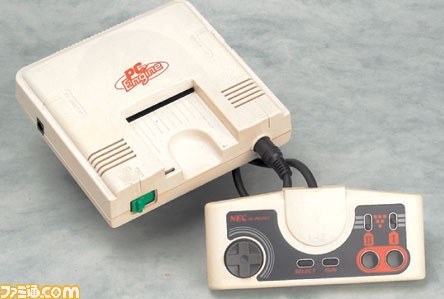
*85: Yu Yu Jinsei is a video board game that was released by Hudson Soft (currently Konami Digital Entertainment) in 1988 for the Turbografix-16. It’s based on the Japanese version of Jinsei Game board game that was sold in 1983, and can be played by up to 5 players.
*86: Tetsudo-Oh is a video board game that was released by dB-SOFT in 1987 for the NES. Up to four players spin the wheel and move toward the goal, buying up railroads and competing for wealth as they go.
*87: Momotaro Dentetsu is a video board game that was released by Hudson Soft (currently Konami Digital Entertainment) in 1988 for the NES. Players become the president of a railway and roll the dice to proceed toward a randomly chosen goal, buying up famous properties and increasing their wealth along the way. The player with the most wealth at the end wins.
Next time, we’ll hear about PC and arcade games of the 80s, how Hideki Kamiya got interested in joining the games industry, and more tales of fun and gaming from the Kamiya brothers.